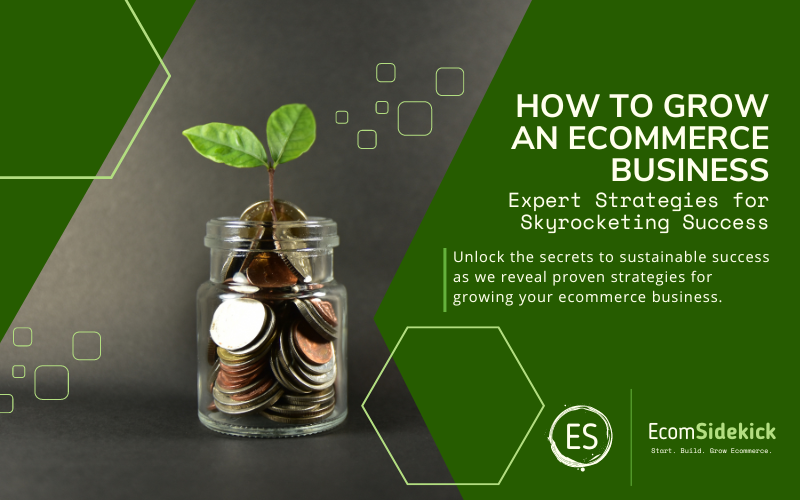Growing your eCommerce journey is simple and straightforward with our detailed guide. From customer acquisition to conversion optimization, we simplify the process, saving you time and money. Learn definitively how to grow an eCommerce business.

- Step 1: Customer Acquisition Strategy – Drawing the Right Audience
- Step 2: Conversion Optimization Strategy – Transforming Visitors into Buyers
- Step 3: Upselling – Maximizing Your Revenue
Step 1: Customer Acquisition Strategy
Growing an eCommerce empire begins with a crucial first step: customer acquisition. We’re not just talking about any visitors, though. The aim is to ensure the right audience – those who would genuinely value your offerings – are aware of your store and the top-notch products or services you’re set to deliver.
Here are the top strategies to catch the attention of those potential customers
1. Paid Ads
Make your mark in the digital space by leveraging targeted advertising. Here are some of the most potent platforms you can utilize:
- Google Ads: Imagine having a billboard in the digital highway. Google Ads offer a hyper-targeted advertising approach that ensures your budget is utilized to reach those already seeking products similar to yours.
- Facebook Ads: Capitalize on Facebook’s immense user base and precision targeting based on specific demographics, likes, and interests. Whether you’re advertising eco-friendly handmade soap to environmentally conscious millennials or high-tech gadgets to worldwide tech aficionados, Facebook has the tools to zero in on your target market.
- Instagram Ads: Owned by Facebook, Instagram offers visual-centric advertising. With its focus on aesthetics, it’s ideal for products that photograph well. From fashion to food to home decor, Instagram can help showcase your products in the best light.
- Pinterest Ads: For eCommerce businesses that have visually appealing products or cater to DIY, home decor, fashion, and similar niches, Pinterest ads can be extremely effective. These ads appear within the user’s feeds, creating a seamless browsing experience.
- LinkedIn Ads: If your eCommerce business is B2B or targets professionals in specific industries, LinkedIn can be a gold mine. With advanced targeting options, you can reach professionals based on their job title, company, industry, skills, and more.
- YouTube Ads: YouTube, the second-largest search engine after Google, provides excellent visibility. Its video ads can be engaging, making it a prime platform for product demonstrations or sharing customer testimonials.
- Twitter Ads: For brands seeking a conversational approach, Twitter fits the bill. Its ads can engage users in discussions, making it an excellent platform for customer engagement and real-time feedback.
- TikTok Ads: Favored by a younger demographic, TikTok is the go-to platform for brands that resonate with Gen Z and Millennial audiences. With its focus on short, creative videos, it’s perfect for brands that can tell a visual or experiential story.
2. Content Marketing
This strategy involves creating and sharing valuable, free content to attract potential customers. The content, whether in the form of blogs, videos, infographics, or podcasts, should address the needs or interests of your audience. Consistent delivery of quality content not only builds trust but also boosts your SEO, thereby attracting organic traffic.
3. Email Marketing
Email marketing remains a cost-effective customer acquisition strategy. By offering a newsletter or incentives for email sign-ups, you create a direct line of communication with potential customers. This allows you to nurture these leads with regular updates, promotional offers, and personalized content.
4. Influencer Marketing
This involves collaborating with influencers who have sway over potential buyers. Influencers have established, engaged audiences that trust their recommendations. When the influencer’s audience aligns with your target audience, this strategy can be especially effective.
5. Affiliate Marketing
In affiliate marketing, you partner with individuals or businesses who promote your products and receive a commission on sales made via their referrals. This strategy enables you to reach new audiences and increase sales with minimal risk.
By combining these strategies effectively, understanding your customers, and tracking your progress via analytics, you can create a robust customer acquisition strategy.
Remember, it’s all about striking a balance between paid advertising and organic methods.
Browse these resources to help you understand and excel at customer acquisition strategies:
- AI Content Optimization: What It Is and How to Do It
- AI for SEO: The Ultimate Guide to Use Cases and Tools
- AI in Advertising: Everything You Need to Know
Step 2: Conversion Optimization Strategy

Alright, you’ve caught the attention of potential customers and they’ve landed on your website. Great job! But what’s next? That’s where the magic of conversion comes into play.
Your mission here is to guide these visitors along a smooth, trouble-free journey that takes them from simply browsing to making a purchase. And this is where funnels and marketing automation tools strut their stuff.
Here are some platforms that play a starring role:
1. ConvertKit: This is an email marketing tool tailored for online creators. Its functionality extends beyond just sending emails. You can segment your subscribers based on their interests or behaviors, send targeted content, and create automated email funnels. For instance, you could create a welcome series for new subscribers, which gradually introduces them to your brand and products, and encourages them to make their first purchase.
2. LeadPages: This is a landing page builder that lets you create conversion-optimized landing pages without any coding skills. You can use it to build product-specific landing pages for your ad campaigns, featuring clear calls-to-action and compelling copy to convince visitors to buy. For example, if you’re launching a new product, you can create a dedicated landing page with all the details, testimonials, and a “Buy Now” button.
3. HubSpot: A comprehensive marketing, sales, and service platform, HubSpot helps you manage your entire customer journey. With its marketing hub, you can automate emails, manage your social media, optimize your content for SEO, and more. Its CRM (Customer Relationship Management) allows you to keep track of every interaction with your customers, which could be useful for personalizing your communications and offers.
4. Marketo: An advanced marketing automation platform, Marketo provides solutions for email marketing, social media, digital advertising, and analytics. It’s particularly well-suited for businesses that need to manage and nurture a lot of leads. Suppose you’re an eCommerce store with a wide range of products catering to different customer segments. With Marketo, you can automate targeted campaigns for each segment, keeping your communication relevant and effective.
5. Unbounce: This platform allows you to create and test custom landing pages, popups, and sticky bars to improve conversion rates. With features like dynamic text replacement, you can personalize landing pages based on the search terms used by visitors. Imagine a visitor lands on your page after searching for “vintage leather boots.” With Unbounce, the headline of your landing page could automatically adjust to match this search term, making your page more relevant and enticing to the visitor.
6. Optimizely: With Optimizely, you can conduct A/B testing on your website and marketing campaigns to identify what works best for conversion. Let’s say you’re unsure whether a green or red “Add to Cart” button leads to more conversions. With Optimizely, you can test both versions and make data-backed decisions.
Remember, conversion optimization is not a one-time task but a continuous process. You should always be testing, learning, and improving.
By implementing these tools and strategies, you’ll be well-equipped to guide your visitors towards making a purchase, transforming them from casual browsers to loyal customers. Now, let’s take a closer look at upselling.
Browse these resources to help you learn more on conversion optimization:
Step 3: Upselling
Alright folks, it’s time for the grand finale of our ecommerce growth guide: upselling. This is your chance to max out the value of each customer transaction. How? By offering an upgrade to a high-quality product, or by suggesting related products that pair beautifully with the customer’s choice.
Picture this: Your customer is just about ready to checkout with a basic coffee maker in their cart. Just before they do, a pop-up message introduces them to a luxury coffee maker, complete with a built-in grinder and a pack of premium coffee beans, all at a combo price.
This clever strategy not only gives your revenue a healthy boost but also creates a value-packed shopping experience for the customer.
How to Grow an Ecommerce Business: Platforms That’ll Help You Execute Upselling Like a Pro

1. Shopify In-cart Upsell: This is a must-have feature for Shopify users. It’s designed to suggest premium alternatives or additional products to customers right before checkout.
2. ConvertKit: An email marketing tool, ConvertKit can help you send personalized upsell offers to your customers. If a customer buys a beginner-level online course, you could send them an email with an attractive offer for the intermediate-level course.
3. Mailchimp: Similar to ConvertKit, Mailchimp also lets you send customized upsell offers via email. It’s an easy way to extend enticing upgrades and add-ons to your customers post-purchase.
4. Kibo (formerly Monetate): This platform uses the power of AI to provide personalized product recommendations, making it easier to suggest relevant upsells and cross-sells based on customer preferences.
5. Dynamic Yield: Just like Kibo, Dynamic Yield uses AI for personalized product suggestions. This tool understands customer behavior and helps you tailor your upsell offers accordingly.
6. Beeketing: This marketing automation tool is built exclusively for ecommerce and provides an array of features, including a smart upsell and cross-sell pop-up tool to engage customers effectively.
7. Zipify: This is an invaluable tool for creating effective upselling funnels. With unique features tailored for Shopify stores, Zipify allows you to easily implement and manage upselling strategies.
8. Samcart: This platform provides a top-tier cart setup with built-in upsell and cross-sell capabilities. With Samcart, your upselling strategies can take center stage.
9. ReConvert: With this tool, you can design custom thank-you pages loaded with targeted upsell offers. Imagine a customer buying a digital camera and landing on a thank-you page offering a discounted lens or an extended warranty.
10. Klaviyo: This is another powerful email marketing platform that helps you send targeted upsell emails. If a customer has recently purchased running shoes from your store, Klaviyo can help you send them an offer for running gear accessories.
So there you have it – the grand finale in our journey towards ecommerce growth. Remember, upselling isn’t just about adding to your revenue; it’s about enriching your customer’s shopping experience.
Here is further reading on helping you to start, build and grow your ecommerce business:
Frequently Asked Question
What Role Does Customer Experience Play in Ecommerce Growth?
Customer experience is paramount in ecommerce growth. Providing a seamless and user-friendly online shopping experience encourages customer satisfaction, repeat business, and positive word-of-mouth referrals. Make sure your website is easy to navigate, mobile-friendly, and has fast loading times. Offer multiple payment options and a straightforward checkout process. Promptly address customer inquiries and concerns to build trust and loyalty.
How Can I Drive More Traffic to My Ecommerce Store?
To drive more traffic to your ecommerce store, focus on SEO to improve your website’s visibility in search engine results. Invest in content marketing, create valuable blog posts, and product guides that attract and engage your target audience. Leverage social media platforms to promote your products and engage with your followers. Consider paid advertising on platforms like Google Ads or social media ads to increase your reach. Collaborating with influencers and running promotions or discounts can also draw attention to your store.
Is Expanding to New Marketplaces Beneficial for Ecommerce Growth?
Expanding to new marketplaces can be advantageous for ecommerce growth. Diversifying your sales channels can increase your brand exposure and reach a broader audience. Consider selling on popular marketplaces like Amazon, eBay, or Etsy, in addition to your standalone website. Each platform has its unique advantages and audience, so research and tailor your approach to suit each marketplace. Remember to maintain consistent branding and customer experience across all channels.
Paul Martinez is the founder of EcomSidekick.com. He is an expert in the areas of finance, real estate, eCommerce, traffic and conversion.
Join him on EcomSidekick.com to learn how to improve your financial life and excel in these areas. Before starting this media site, Paul built from scratch and managed two multi-million dollar companies. One in the real estate sector and one in the eCommerce sector.

